Special title, is it not?
All I really want to do is pick your brains. So read on! I was looking at Hannibal Rome v Carthage with renewed interest after my successful engagement with the title in Seattle.
My original intent for buying the game has always been to play it as a campaign, and use the ‘battles’ to generate Great Battles of History tactical scenarios!
I know that I have enjoyed playing thru the 2nd Punic War using the campaign rules from one of the C3i magazines, so once more into the breach would be awesomeness and unique each play!
How to determine for mix?
If according the experts on BGG 1 Combat Unit in Hannibal : Rome v Carthage is worth 5,000 men then could we not re create battles in the Great Battles of History system for each battle we have in the H:RvC title?
Well…could we?
Napkin sketch time!
Above in Column 1 is the Year in H:RvC terms, then TQ – or Troop Quality ratings over that time period based upon the GBoH scenarios.
The last columns are force mix by unit types in Great Battles of History (GBoH) based upon various scenarios.
The various unit types would need to be represented proportionately and change over time as they did historically. For instance Cavalry figured less prominently at the end stages of the 2nd Punic War relative to Rome, as Africanus began to leverage the power of cavalry and his formations flexibility. Hannibals numeric advantage and tactical capabilities were thus diminished in regards to Cavalry.
Similarly Hannibals morale of his armies was incredibly high due to the loyalty to him for nearly a decade. Romes tropp Morale was conversely low as the ability to lead or lack thereof caused morale problems, but this was resolved over time and can be reflected in the Roman TQ rating going up slowly over time.
The last messy column attempts to capture Roman Force mixes.
Rome had Alae legions made up of conscripts, what I will call regular or average Legions and Elite Legions. Depending upon battle location we are more likely to run into Alae say in the Iberian Peninsula than the Italian mainland? – Probably.
We can keep the force mix a “surprise” by rolling on a simple table for what the CU’s will be comprised of. For example with a 1 in 10 chance of at least one Elite Legion being present, 8 in ten for Regulars and 2 in ten for Alae, increasing outside of Italy to 4 in ten for Alae.
OR….I can get all historical and put the actual Legions in…too hard?
I did some rough sums on force mix for both sides at Zama and Cannae the bookend battles.
I like the force mix ratios for both sides, but might bump up the PH/HI factor subject to location and or substitute in additional 1 hex sized counters for double Phalanx counters. My thinking here is the closer to home the more likely we are to see more Heavy Units and less mercenary/tribal forces.
This then leaves us with dealing with losses on retreats? I think we take something like the loss difference in TQ points and make that the equivalent #of CU’s lost after factoring in the 5k per CU number.
Those pesky combat cards and actual leader units on the board need to be dealt with also.
Perhaps we cycle in Hannibal leader ship team based upon what is actually on the board and historical presence. The Romans will need to lead with who they have on the board and subordinate leaders I guess.
As for the combat cards, if a army has an overwhelming advantage in the Battle Cards earned we provide them with some additional forces OR Elite Initiative for 2 turns rather than one?
Love to hear what you folks think. Crazy? Possibly. Fun? YES!
Once I have The Dark Valley Case Blue Scenario knocked out I will have a mostly clear desk for me to experiment in!
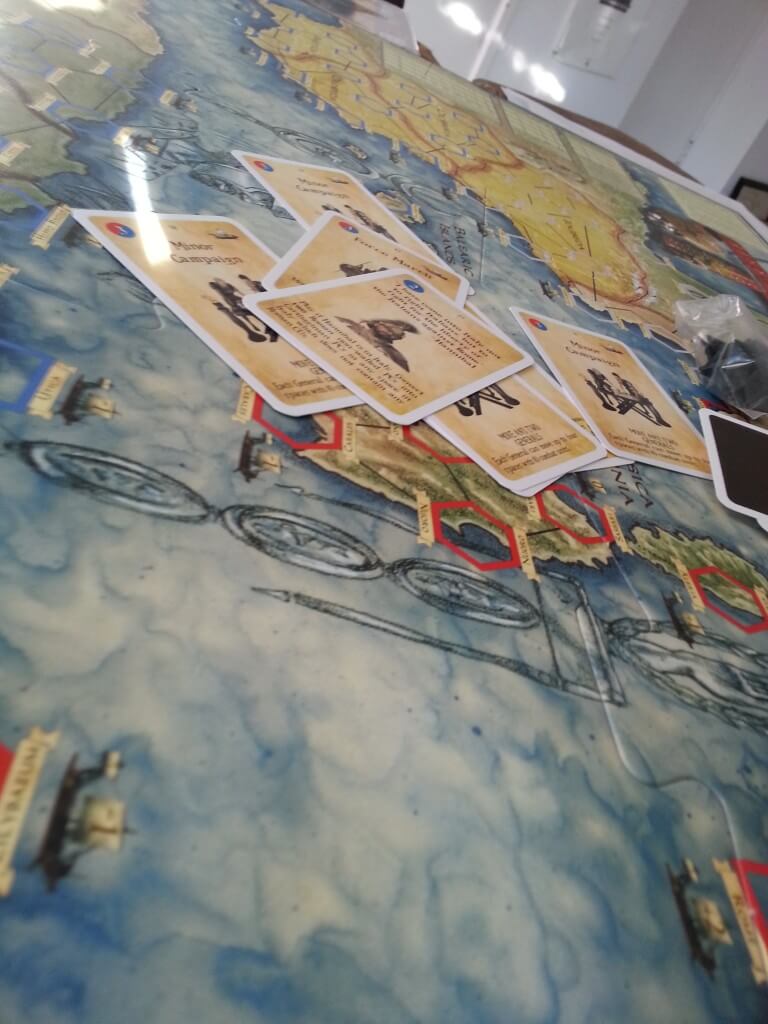
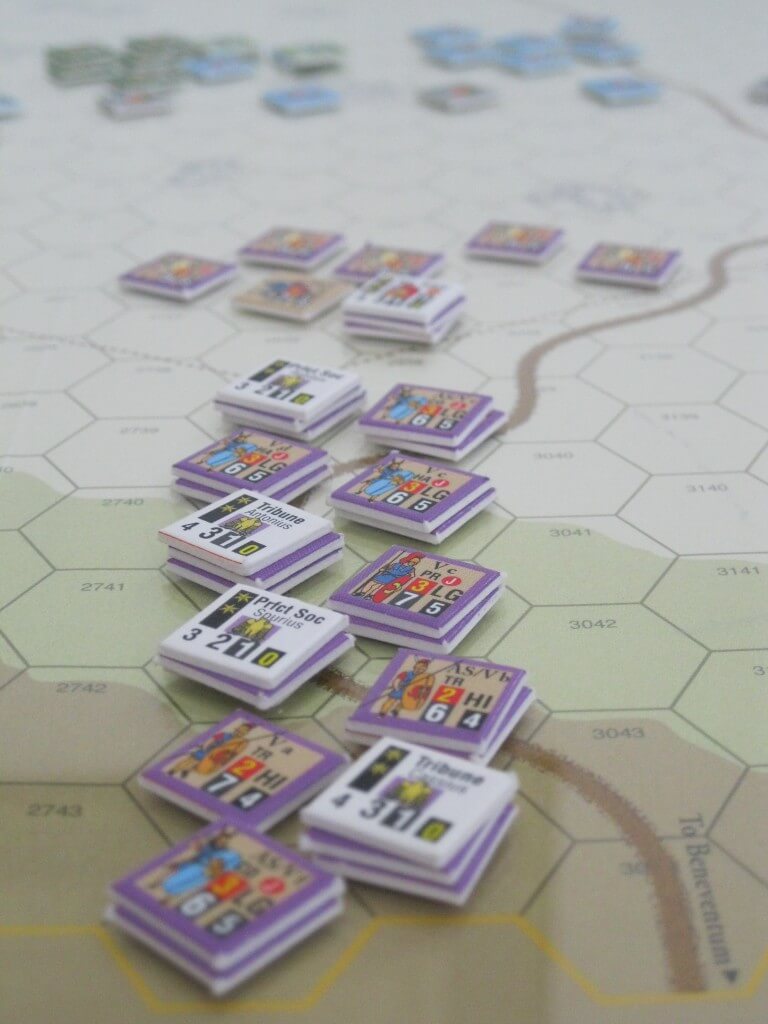
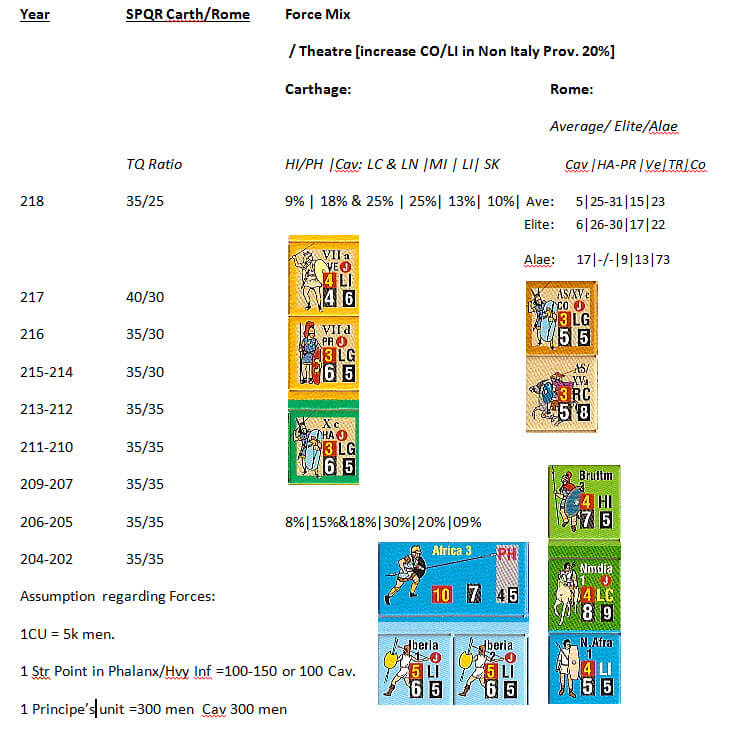
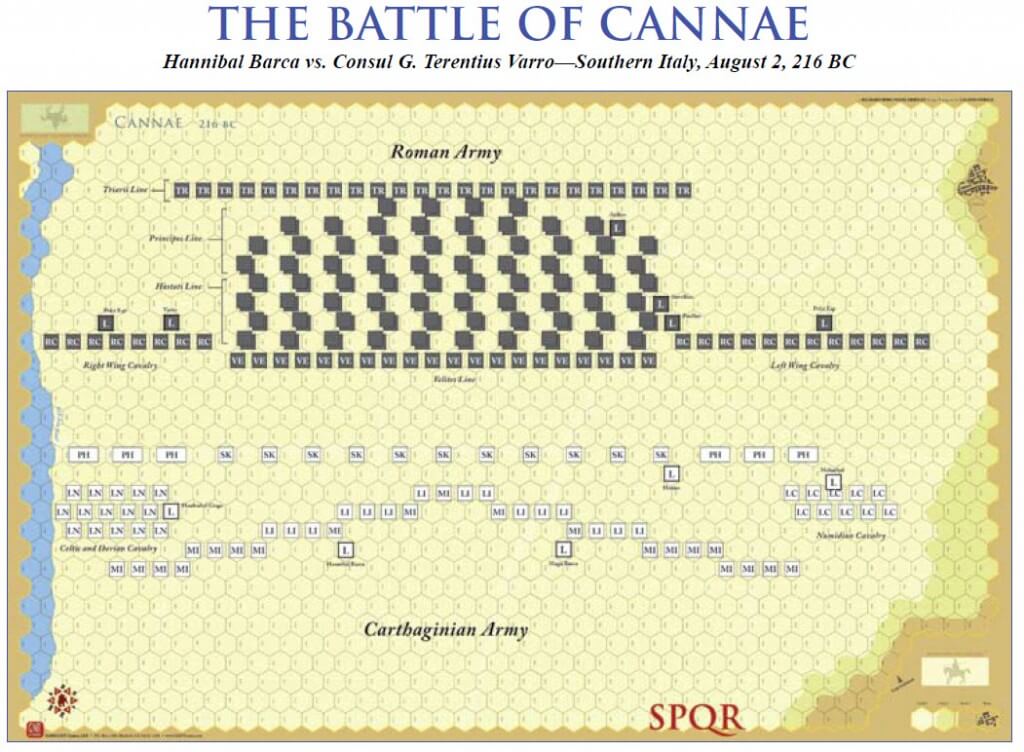
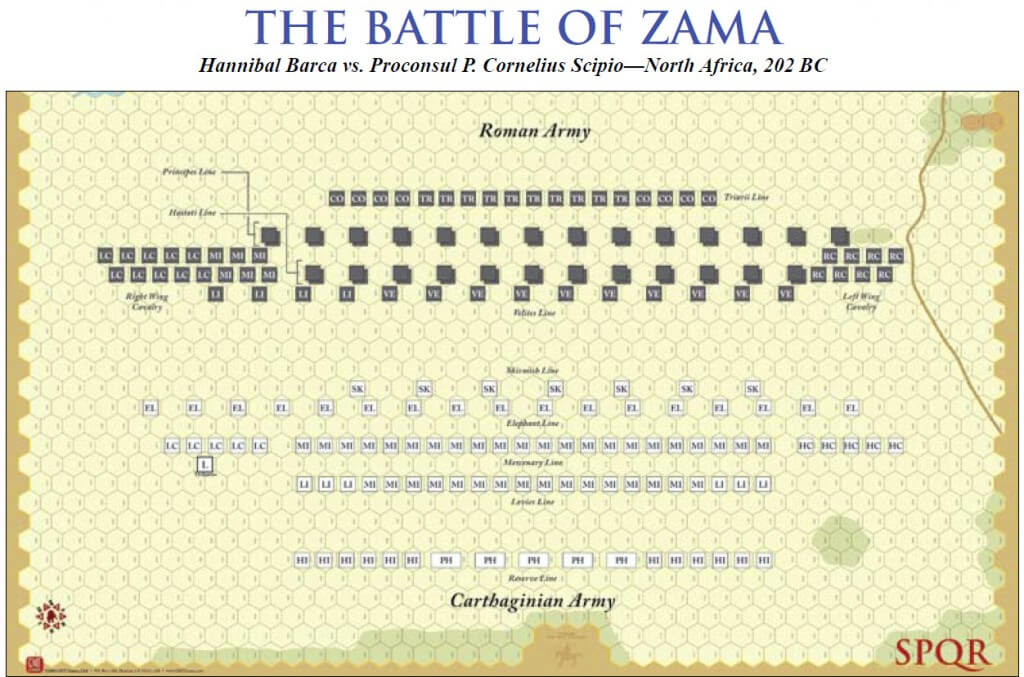
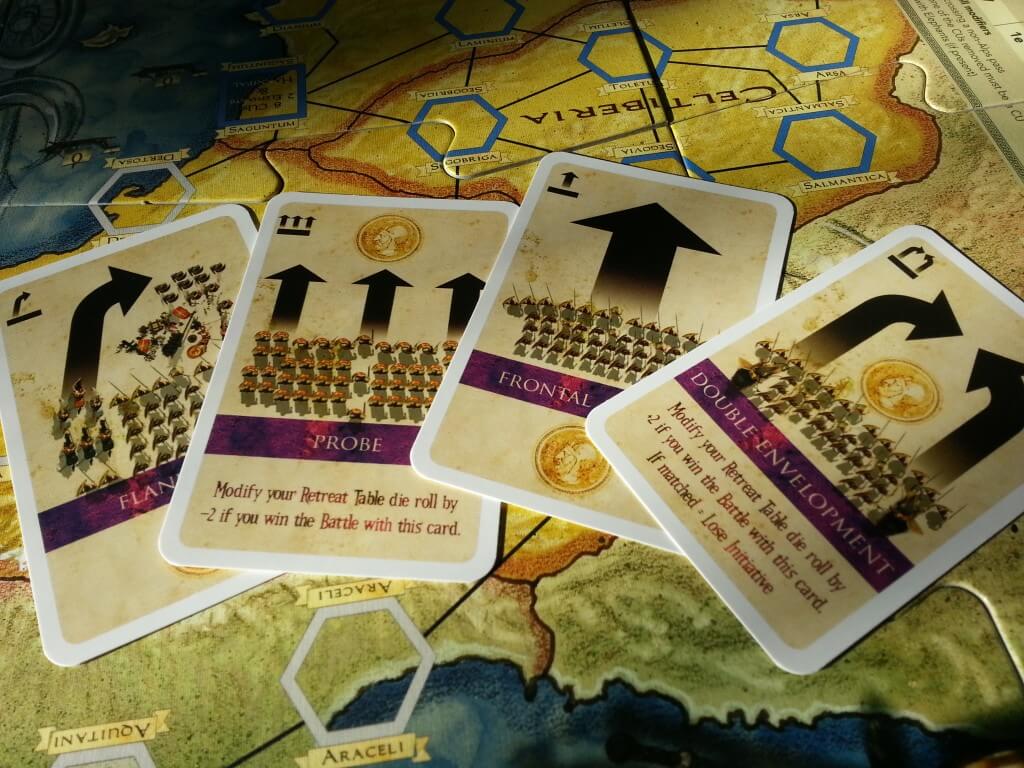
There can’t be that many armies about – you could keep track on paper and have newly raised Legions be green, award regular and elite status based on the results of the battles themselves. You could even keep track of the age of units and ‘muster out’ aged legions and replace them with greener ones. Another way to dilute them is to use losses – if an elite unit loses lots of men, it merges with a lesser unit and loses its eliteness.
Rome could start the war being able to raise a few legions with some experience early in the war, but after that you’d figure all new units would be green. You could also factor in some attrition for units hanging out year after year – subtract some wastage and add equivalent green troops as replacements to keep up the strength points.
For Hannibal you could so a similar thing – figure that most replacements in Italy would be Gauls and Italians and low quality until they have seasoning for a while.
OH!!! I like that Idea. I was going to simply apply a formula. But keeping track of replacements per turn is easy. H:RvC, mandates the new units, unless you spend a high cost card to buy a Legion. Superb. So glad you read my posts!
There are some details to work out, which is hard because I don’t have either game, but I like the idea of giving the generals a reason to want to conserve the elite units for future battles rather than to lead with the best troops like paper gamers tend to do, or win by having 2 units remaining rather than 1. Real generals like to conserve force for later days.
Interesting idea. I have both H:RvC and SPQR so I’m definitely interested. What you are proposing is almost what is done in the computer game Rome:Total War (minus the city building stuff). I really wish someone would come up with an alternative to the battle card mechanic but that is another issue.
Yep!!!!
The Battle Card thing is a bit lame, but I like the ‘poker, bluffing thingy’ aspect to it. I’m hoping this will be a cool experience. I started something similar with A Most Dangerous Time. But ran afoul of the game itself.
Great work and a great concept, one that connects a tactical level game to the operational/strategic level with its associated political context. Translating from one to the other, in terms of force size, seems to be relatively straightforward but doing so for force mix and accounting for factors such as quality and experience (such as TQ and Legion type in SPQR) is more difficult. You, Kevin, made a lot of progress down that road. Once or twice I’d thought of taking on something like this and it struck me that the force mix could be derived from the SPQR scenarios, just as you have done.
If a fairly straightforward system could be crafted for Hannibal and Rome, then it ought to be feasible to use or adapt it for others. For example, when Hoplite is published by GMT games it might be possible to do something similar with the block game Hellenes – the Peloponnesian War.
I’ll have some more thoughts on this so I’ll drop you an email or two.
Please do!
My intention is to use some method of preservation/maturation of forces.
Veteran Mature Legions fighting such that they live to fight another day, not blowing thru Vets. See Oldcats comments below. Then as losses in RP are counted up at battle end and tracked by Legion we buy in game replacements. Each new Legion sent from Rome would be ‘green’, until 2 campaign seasons pass or similar. The units with losses would be rebuilt out of the new forces IF they end up in the same area. I could apply some straight line degradation. 50% loss replacement = reduction to regular, 50%+ CO. Then note that and ‘swap teh GBoH LEgions out for the next battle, see how that flies. I dont want to make it a nightmare to manage….or more of a nightmare to manage!!
In my view the question of simulating non-combat unit erosion or attrition in a game is a difficult one as there is little hard evidence to go on, given the lack data in historical sources. It’s not unreasonable to make the attempt but it can become both complex and a distraction from conducting a game. In a challenging game, whether strategic/operational or tactical, players will want to assess the situation, develop a plan and act on it, without having to also do too much accounting for non-combat attrition.
So if there’s not likely to be any significant and relative difference between two opposing forces in a game due to non-combat attrition why go to the trouble of simulating it? The small difference it makes probably won’t be worth the time it takes and could detract from the experience of combining two game levels – strategic/operational with tactical.
The better alternative may be to use a game that already has an elegant non-combat attrition mechanic. And here I’m thinking of Richard Berg’s Ancient World Series and a game like Carthage, which has an innovative and straightforward game mechanic for attrition, both movement attrition and inertia (static) attrition. The well-stated rationale for movement attrition was:
“Attrition is the gradual erosion of strength an army suffers from
extended movement, movement through difficult terrain, movement
through areas where food and supplies are difficult to procure,
simply staying in one place and eating everything in sight,
and/or a combination of all of the above. Essentially, Attrition is
what prevents a player from moving all over the place in a single
turn. The larger the force, and the farther it moves, the more
likely it is to suffer losses.”
And the point of inertia attrition was:
“Forces that do not move outside a province for the entire game turn are subject to possible Attrition because of the difficulty of supplying a large body of men for an extended period of time in one locale.”
If you want to go down the road of simulating non-combat attrition, then I’d suggest adapting Richard Berg’s attrition mechanic. For movement attrition, his mechanic accounts for the size of a force, the distance it moves, and the terrain it moves through. For inertia attrition, his mechanic accounts for the size of the force, and the terrain in its location, such as whether it is in a city.
It would mean that in using Hannibal: Rome vs. Carthage, you’d need to account for the distance moved between spaces on the map, the terrain type in each space and the force size. It could be done and I would be willing to help. It might be easier though to take Richard Berg’s Carthage, an operational level game, and use that to generate battles with SPQR, for example. Now I’d be willing to game that with you, for sure, as soon as Hoplite is published and I have some gaming time (am currently heavily involved the playtesting for Hoplite).
Great comments as always. I had Carthage once upon a time…. darn it.
I think old cats ideas to account for seasoning of troops caught my attention. But t house edge difference in tq’s is probably not worth the effort. The bigger factor was leadership. Ably represented already.
I’ll be using simple gboh for this with some command tweaks.